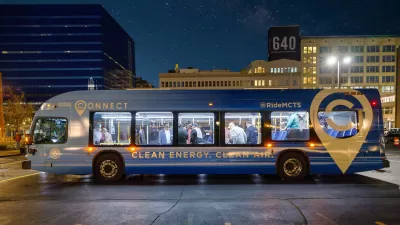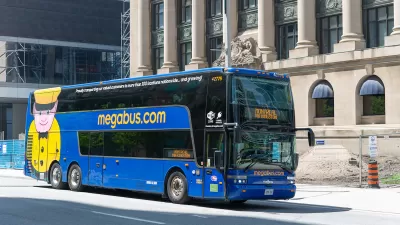A new study compares regional population densities to transit systems to find out which transit systems have maximized their reach.

Andrew Small shares news of a new study from the Institute for Transportation & Policy that "measures how many people live within walking distance (1 km) of high-quality rapid transit, either light rail or bus transit, in 26 cities and metros around the world."
Using bus rapid transit standards of transit service, the study then compared the transit systems of 13 metropolitan areas to the population densities of those same areas. "The top four cities with the largest populations near rapid transit were Paris, Barcelona, Madrid, and London, reaching more than 90 percent of their city populations," according to Small.
One key point to be made, however, is the difference between transit coverage in the core areas of these cities compared to the reaches of their suburban periphery. "For example, 100 percent of population of the city of Paris has access to rapid transit, but only 50 percent of its larger metro population has access to the rapid transit shed that extends beyond city boundaries."
Of the cities examined in the study, U.S. cities performed well below average. "The six U.S. cities included in the study averaged a score of 17.2 percent on their metro-area service reach," according to Small, with New York City leading the way with transit accessible to 77 percent of residents living in the city and 35 percent of residents living in the metropolitan area.
FULL STORY: What Cities Have the Most People Living Near Rapid Transit?

Alabama: Trump Terminates Settlements for Black Communities Harmed By Raw Sewage
Trump deemed the landmark civil rights agreement “illegal DEI and environmental justice policy.”

Planetizen Federal Action Tracker
A weekly monitor of how Trump’s orders and actions are impacting planners and planning in America.

The 120 Year Old Tiny Home Villages That Sheltered San Francisco’s Earthquake Refugees
More than a century ago, San Francisco mobilized to house thousands of residents displaced by the 1906 earthquake. Could their strategy offer a model for the present?

In Both Crashes and Crime, Public Transportation is Far Safer than Driving
Contrary to popular assumptions, public transportation has far lower crash and crime rates than automobile travel. For safer communities, improve and encourage transit travel.

Report: Zoning Reforms Should Complement Nashville’s Ambitious Transit Plan
Without reform, restrictive zoning codes will limit the impact of the city’s planned transit expansion and could exclude some of the residents who depend on transit the most.

Judge Orders Release of Frozen IRA, IIJA Funding
The decision is a victory for environmental groups who charged that freezing funds for critical infrastructure and disaster response programs caused “real and irreparable harm” to communities.
Urban Design for Planners 1: Software Tools
This six-course series explores essential urban design concepts using open source software and equips planners with the tools they need to participate fully in the urban design process.
Planning for Universal Design
Learn the tools for implementing Universal Design in planning regulations.
Clanton & Associates, Inc.
Jessamine County Fiscal Court
Institute for Housing and Urban Development Studies (IHS)
City of Grandview
Harvard GSD Executive Education
Toledo-Lucas County Plan Commissions
Salt Lake City
NYU Wagner Graduate School of Public Service





























